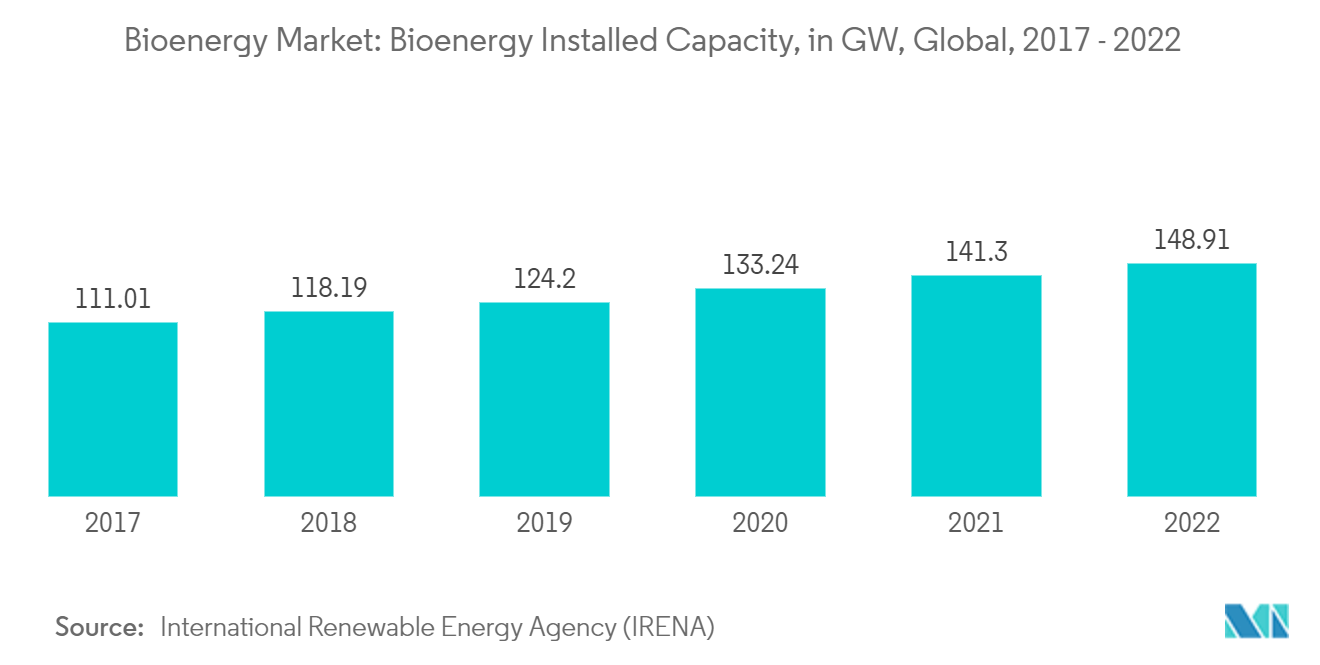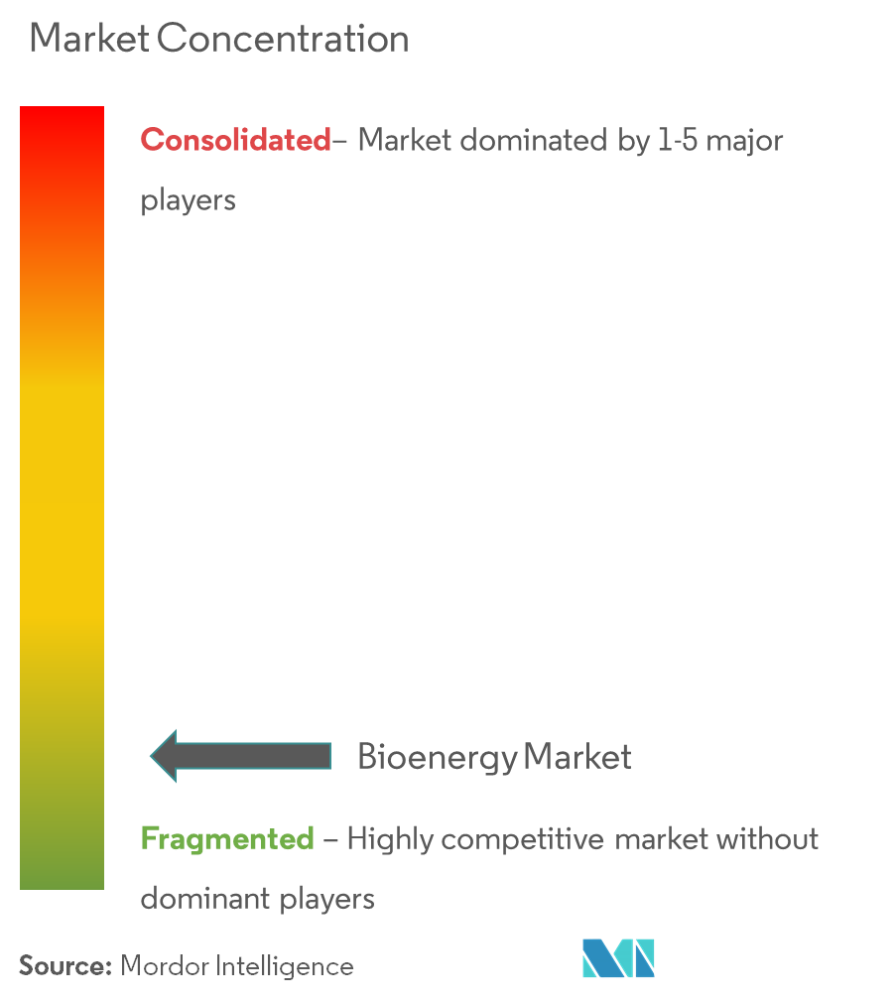Bioenergy Market Size

| Study Period | 2020 - 2029 |
| Base Year For Estimation | 2023 |
| CAGR (2024 - 2029) | 5.82 % |
| Fastest Growing Market | Asia Pacific |
| Largest Market | Europe |
| Market Concentration | Medium |
Major Players*Disclaimer: Major Players sorted in no particular order |
Bioenergy Market Analysis
The Bioenergy Market size in terms of installed base is expected to grow from 166.14 gigawatt in 2024 to 220.11 gigawatt by 2029, at a CAGR of 5.82% during the forecast period (2024-2029).
- Over the medium term, factors such as increasing investments in bioenergy, and declining electricity generation costs from bioenergy facilities are expected to drive the market during the forecast period.
- On the other hand, the high initial investment for establishing plants may resist market growth. The plant output must be sufficient and consistent to cover the installation and operating costs.
- Nevertheless, Emerging waste-to-energy technologies, such as Dendro Liquid Energy (DLE), a recent German innovation in the biological treatment of waste, present high potential in the bioenergy field, being close to 'zero-waste' technology.
- Europe is expected to dominate the world's market, with most of the demand coming from countries such as Norway, Germany, and the United Kingdom.
Bioenergy Market Trends
Biomass is Expected to Dominate the Market
- Bioenergy is energy derived from biological materials characterized as organic materials with stored chemical energy like wood and manure.
- According to Internation Energy Association, Modern bioenergy is the largest renewable energy source globally, accounting for 55% of renewable energy and over 6% of the global energy supply. The adoption of modern bioenergy has increased on average by about 7% per year between 2010 and 2021 and is on an upward trend.
- According to the International Renewable Association, in 2022, the global installed capacity for bioenergy accounted for about 148.9 GW, with a 5% increase from 2021.
- Biomass supply comes from various feedstock - wood fuel, forestry residues, charcoal, pellets, agriculture crops and residues, municipal and industrial waste, biogas, biofuels, etc. Broadly, the supply can be classified into three main sectors - forestry, agriculture, and waste.
- In June 2023, the Indian government took the initiative to promote sustainable energy practices, and the Ministry of Power announced the revision of the biomass co-firing policy. This revision will enable power plants to purchase biomass pellets at benchmark prices, reducing import dependencies and enhancing the adoption of biomass as a renewable energy source.
- In June 2023, data gathered by the Energy Information Administration (EIA) showed that the total United States densified biomass fuel capacity reached 13.36 million tons in March 2023, with all of that capacity listed as currently operating or temporarily not in operation. Capacity included 1.96 million tons in the East, 10.51 million in the South, and 884,200 tons in the West.
- Therefore, with the increasing demand for renewable energy sources worldwide, biomass-based electricity generation is expected to witness a significant growth rate during the forecast period.

Europe is Expected to Dominate the Market
- Bioenergy is expected to remain crucial over the next decade to reach renewable energy targets in 2030. Hence, the European Union (EU) member states incorporated the bioenergy option in their National Renewable Energy Action Plans (NREAPs).
- Biomass is an essential renewable energy source and is a key factor in reaching the European renewable energy target by 2030, where the target for the share of renewables in the EU energy mix to 45% by 2030
- Bioenergy contributed to 5.8% of the total renewable energy installed capacity in Europe in 2022. Germany is expected to have 6.7% of its total installed capacity from bioenergy in 2023.
- In June 2023, the Energy Ministry of Spain announced plans to double its 2030 biogas and green hydrogen production targets. The revised plan sets a 2030 target of 11 gigawatts (GW) of electrolyzers, up from a previous target of 4 GW and biogas production to 20 terawatt hours (TWh).
- Germany is one of the crucial players in bioenergy, and the country is constantly expanding its bioenergy capacity. In February 2023, BioEnergy Germany company, which specializes in the design, construction, and operation of biogas plants, secured a contract for the construction of a 56 MWel biogas plant in Nkhotakota District in the Central Region of Malawi by BlueHills Capital Projects (Pty) Limited. The biogas plant will be fed with Napier grass from the surrounding plantations.
- Further, countries like Italy are likely to support the region's growth in the bioenergy sector. In June 2023, Enterra secured USD 38 million in project financing from UniCredit for a biomass plant in Italy. Located in Foggia in the southern region of Apulia, the 13 MW plant produces electric and thermal energy from biomass.
- Hence, with the upcoming projects and the targets to achieve a carbon-neutral environment during the upcoming years, the region is expected to have dominancy during the forecast period.

Bioenergy Industry Overview
The bioenergy market is semi fragmented. Some of the major players in the market (in no particular order) include Mitsubishi Heavy Industries Ltd, Hitachi Zosen Corp., BTG Biomass Technology Group, Babcock & Wilcox Volund AS, Biomass Engineering Ltd., and Orsted AS.
Bioenergy Market Leaders
-
Mitsubishi Heavy Industries Ltd
-
BTG Biomass Technology Group
-
Orsted A/S
-
Fortum Oyj
-
Hitachi Zosen Corporation
*Disclaimer: Major Players sorted in no particular order

Bioenergy Market News
- June 2023: Canada's Minister of Natural Resources announced a USD 10 million contribution to BioLesna Carbon Technologies LP, a joint venture between BC Biocarbon and Dunkley Lumber Ltd., for a new biorefinery in Carrot River, Saskatchewan.
- June 2023: Australia's Victorian government announced USD 8 million bioenergy fund, Victoria's largest investment in bioenergy to date, designed to significantly boost the region's bioenergy capacity. The fund supports 24 projects and will ensure that farming and food production waste, such as cooking oil, dairy excess, and vegetable offcuts, will be converted into electricity, heat, gas, or liquid fuel.
Bioenergy Market Report - Table of Contents
1. INTRODUCTION
- 1.1 Scope of the Study
- 1.2 Market Definition
- 1.3 Study Assumptions
2. RESEARCH METHODOLOGY
3. EXECUTIVE SUMMARY
4. MARKET OVERVIEW
- 4.1 Introduction
- 4.2 Bioenergy Installed Capacity Historic and Forecast, till 2028
- 4.3 Recent Trends and Developments
- 4.4 Government Policies and Regulations
-
4.5 Market Dynamics
- 4.5.1 Drivers
- 4.5.1.1 Shift towards Renewable Energy
- 4.5.1.2 Less Electricity Generation Cost from Bioenergy
- 4.5.2 Restraints
- 4.5.2.1 High Initial Investments
- 4.6 Supply Chain Analysis
-
4.7 Porter's Five Forces Analysis
- 4.7.1 Bargaining Power of Suppliers
- 4.7.2 Bargaining Power of Consumers
- 4.7.3 Threat of New Entrants
- 4.7.4 Threat of Substitute Products and Services
- 4.7.5 Intensity of Competitive Rivalry
5. MARKET SEGMENTATION
-
5.1 Type
- 5.1.1 Solid Biomass
- 5.1.2 Biogas
- 5.1.3 Renewable Waste
- 5.1.4 Other Types
-
5.2 Technology
- 5.2.1 Gasification
- 5.2.2 Fast Pyrolysis
- 5.2.3 Fermentation
- 5.2.4 Other Technologies
-
5.3 Geography (Regional Market Analysis {Market Size and Demand Forecast till 2028 (for regions only)})
- 5.3.1 North America
- 5.3.1.1 United States
- 5.3.1.2 Canada
- 5.3.1.3 Rest of North America
- 5.3.2 Europe
- 5.3.2.1 Germany
- 5.3.2.2 France
- 5.3.2.3 United Kingdom
- 5.3.2.4 Italy
- 5.3.2.5 Rest of Europe
- 5.3.3 Asia-Pacific
- 5.3.3.1 China
- 5.3.3.2 India
- 5.3.3.3 Japan
- 5.3.3.4 Australia
- 5.3.3.5 Rest of Asia Pacific
- 5.3.4 South America
- 5.3.4.1 Brazil
- 5.3.4.2 Argentina
- 5.3.4.3 Chile
- 5.3.4.4 Rest of South America
- 5.3.5 Middle-East and Africa
- 5.3.5.1 Saudi Arabia
- 5.3.5.2 United Arab Emirates
- 5.3.5.3 South Africa
- 5.3.5.4 Qatar
6. COMPETITIVE LANDSCAPE
- 6.1 Mergers and Acquisitions, Joint Ventures, Collaborations, and Agreements
- 6.2 Strategies Adopted by Leading Players
-
6.3 Company Profiles
- 6.3.1 Mitsubishi Heavy Industries Ltd
- 6.3.2 MVV Energie AG
- 6.3.3 A2A SpA
- 6.3.4 Hitachi Zosen Corp.
- 6.3.5 BTG Biomass Technology Group
- 6.3.6 Babcock & Wilcox Volund AS
- 6.3.7 Biomass Engineering Ltd
- 6.3.8 Orsted AS
- 6.3.9 Enerkem
- 6.3.10 Fortum Oyj
- *List Not Exhaustive
7. MARKET OPPORTUNITIES AND FUTURE TRENDS
- 7.1 Advanced Technologies
Bioenergy Industry Segmentation
Bioenergy is a source of energy from the organic material that drives up plants, known as biomass. Biomass contains carbon absorbed by plants through photosynthesis. It is a form of renewable energy derived from recently living organic materials known as biomass, which can be utilized to deliver transportation fuels, heat, electricity, and products.
The bioenergy market is segmented by type, application, and geography. By type, the market is segmented as Biodiesel, Bioethanol, and Biogas. By application, the market is segmented as Power Generation, District Heating, Transportation, Industrial Applications, and other applications. The report also covers the market size and forecasts across major regions. For each segment, the market size and forecasts have been done based on installed capacity.
| Type | Solid Biomass | |
| Biogas | ||
| Renewable Waste | ||
| Other Types | ||
| Technology | Gasification | |
| Fast Pyrolysis | ||
| Fermentation | ||
| Other Technologies | ||
| Geography (Regional Market Analysis {Market Size and Demand Forecast till 2028 (for regions only)}) | North America | United States |
| Canada | ||
| Rest of North America | ||
| Geography (Regional Market Analysis {Market Size and Demand Forecast till 2028 (for regions only)}) | Europe | Germany |
| France | ||
| United Kingdom | ||
| Italy | ||
| Rest of Europe | ||
| Geography (Regional Market Analysis {Market Size and Demand Forecast till 2028 (for regions only)}) | Asia-Pacific | China |
| India | ||
| Japan | ||
| Australia | ||
| Rest of Asia Pacific | ||
| Geography (Regional Market Analysis {Market Size and Demand Forecast till 2028 (for regions only)}) | South America | Brazil |
| Argentina | ||
| Chile | ||
| Rest of South America | ||
| Geography (Regional Market Analysis {Market Size and Demand Forecast till 2028 (for regions only)}) | Middle-East and Africa | Saudi Arabia |
| United Arab Emirates | ||
| South Africa | ||
| Qatar |
Bioenergy Market Research FAQs
How big is the Bioenergy Market?
The Bioenergy Market size is expected to reach 166.14 gigawatt in 2024 and grow at a CAGR of 5.82% to reach 220.11 gigawatt by 2029.
What is the current Bioenergy Market size?
In 2024, the Bioenergy Market size is expected to reach 166.14 gigawatt.
Who are the key players in Bioenergy Market?
Mitsubishi Heavy Industries Ltd, BTG Biomass Technology Group, Orsted A/S, Fortum Oyj and Hitachi Zosen Corporation are the major companies operating in the Bioenergy Market.
Which is the fastest growing region in Bioenergy Market?
Asia Pacific is estimated to grow at the highest CAGR over the forecast period (2024-2029).
Which region has the biggest share in Bioenergy Market?
In 2024, the Europe accounts for the largest market share in Bioenergy Market.
Bioenergy Industry Report
Statistics for the 2024 Bioenergy market share, size and revenue growth rate, created by Mordor Intelligence™ Industry Reports. Bioenergy analysis includes a market forecast outlook to for 2024 to 2029 and historical overview. Get a sample of this industry analysis as a free report PDF download.



